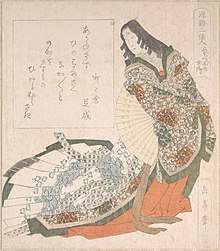Lady Fujitsubo
Lady Fujitsubo (藤壺) is a fictional character in Murasaki Shikibu's The Tale of Genji (Genji Monogatari).

Biography
Daughter of a previous emperor and thus imperial princess, Fujitsubo enters the service of Kiritsubo Emperor at age 16, mainly because of her resemblance to the deceased Kiritsubo Consort. She soon becomes an imperial favorite, but also Genji’s childhood crush and later lifelong obsession. By chapter seven, "Momiji no ha", it becomes obvious that Fujitsubo and Genji are already involved in an illicit love affair (although the author does not describe it, but rather implies the beginning of the relationship), the result of which is the birth of Reizei (future emperor) whom everyone, except the two lovers, believes to be the son of the Kiritsubo Emperor. Elevated to the rank of Empress and having her son named Heir Apparent (Reizei is supposed to succeed Suzaku), Fujitsubo gradually grows more and more troubled by guilt and the fear of having her secret exposed. Once Genji's advances intensify and, in the public realm, the faction of the Kokiden Lady comes to power, Fujitsubo's only countermeasure is to take vows and become a nun ("Sakaki"). By this, she hopes on the one hand, to permanently put Genji off and eliminate the risk of their affair being discovered and, on the other hand, to reassure Kokiden that she renounces any secular, political claims to power. After Genji’s return from exile, she forms a political alliance with him and turns into a genuine "politically ambitious"[1] figure in the tale. Only on her deathbed (in "Usugumo") does she return to being a romantic heroine.[2]
Reception and analysis
Fujitsubo’s importance in the tale lies beyond her immediate contribution to the plot, in what Norma Field termed as being an "original substitute"[3] (she makes her debut as a substitute for Kiritsubo, yet, later, Genji will look for substitutes for her, in women such as Utsusemi, the Third Princess, but most of all, in Murasaki).
Notes
- Norma Field, The Splendor of Longing in The Tale of Genji, 1987, 30.
- Norma Field, The Splendor of Longing in The Tale of Genji, 1987, 44.
- Norma Field, The Splendor of Longing in The Tale of Genji, 1987, 24